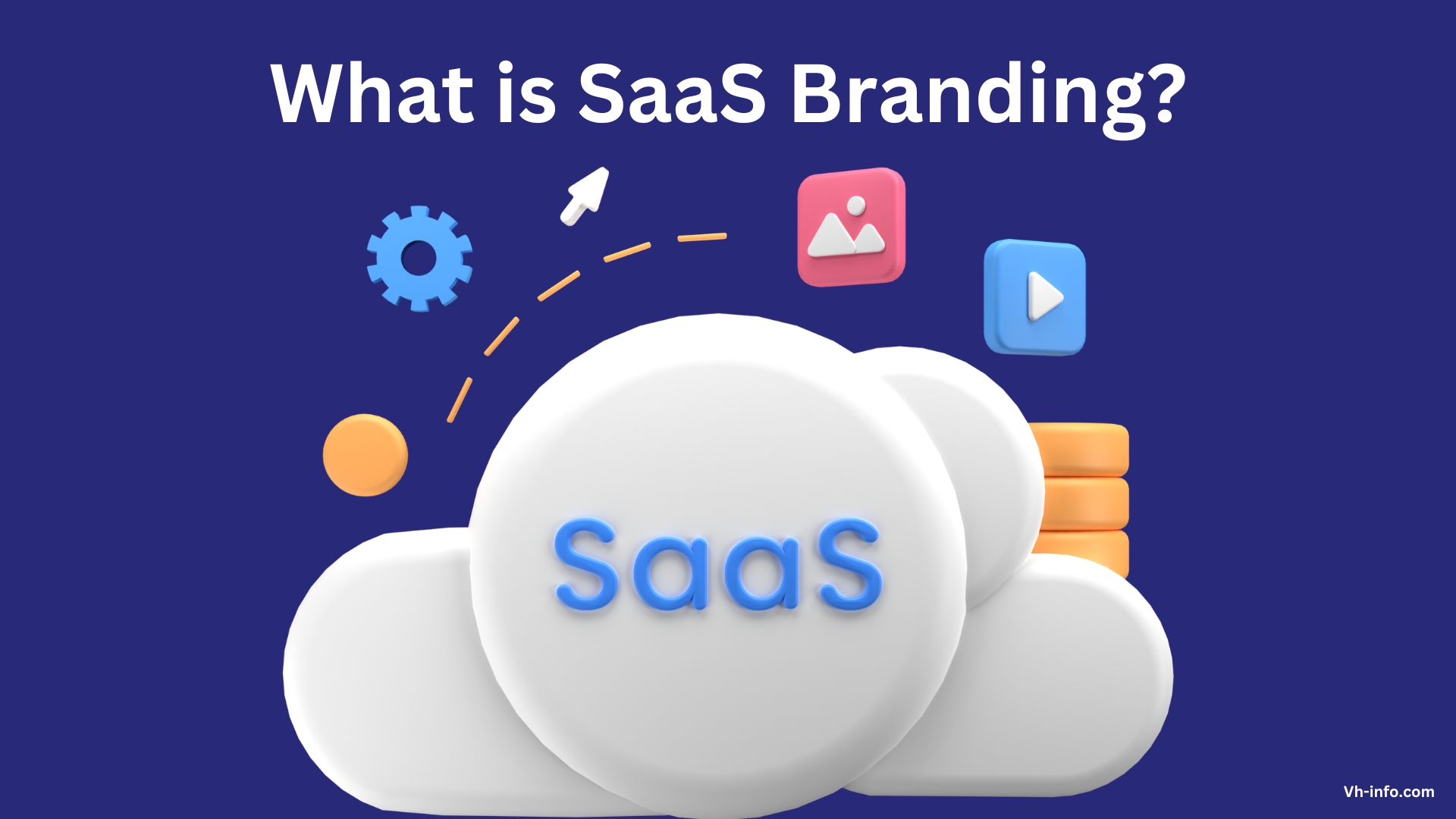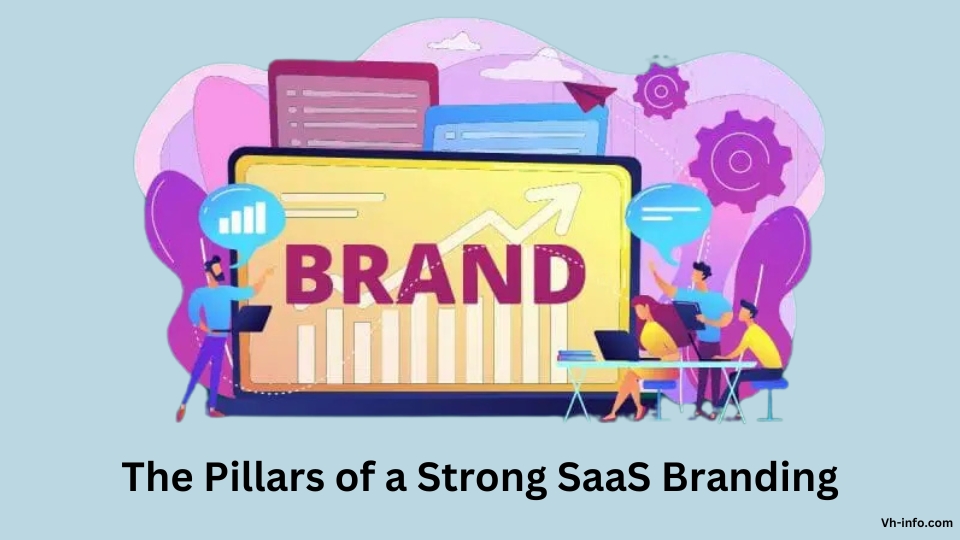In the competitive SaaS industry, having a strong brand is no longer optional—it’s essential. A well-defined SaaS branding strategy not only sets your software company apart in a crowded market but also builds trust, fosters customer loyalty, and drives business growth.
Whether you’re a startup or an established SaaS business, creating a cohesive brand identity, tone of voice, and customer experience is pivotal to achieving long-term success.
This article will guide you through the fundamentals of SaaS branding, its importance, challenges, and actionable strategies to help your SaaS product stand out.
What is SaaS Branding?

SaaS branding is the process of creating a unique identity for your software-as-a-service company that resonates with your target audience.
It encompasses everything from your visual identity—such as your logo, color palette, and typography—to your brand messaging, tone of voice, and customer experience.
Effective SaaS branding helps communicate your core values, establish credibility, and create a lasting impression on potential customers.
A successful SaaS brand goes beyond aesthetics. It represents your mission statement, solves customer pain points through your SaaS solution, and builds an emotional connection with users.
In short, it’s how your SaaS business positions itself in the market and differentiates itself from competitors.
The Pillars of a Strong SaaS Branding

A strong SaaS brand is built on several key pillars that work together to create a cohesive and impactful identity.
Let’s break down each of these pillars:
Brand Identity
Your brand identity is the foundation of your SaaS branding. It includes the visual elements, tone of voice, and personality that define how your software company is perceived by your target audience.
A strong brand identity helps your SaaS product stand out in a crowded market while creating a lasting impression on potential customers.
Visual Identity (Logo, Color Palette, Typography)
Visual identity refers to the design elements that represent your SaaS brand, such as your logo, color palette, and typography.
A perfect logo acts as the face of your brand, while a consistent color scheme and typography ensure uniformity across all touchpoints. These visual cues are essential for building brand recognition and making your SaaS business memorable.
Brand Voice and Tone
Your tone of voice reflects the personality of your SaaS brand and how you communicate with your target audience.
Whether it’s professional, friendly, or authoritative, maintaining consistency in your tone across platforms builds trust and strengthens your brand image. A clear tone of voice also ensures that your messaging aligns with your core values and resonates with potential customers.
Brand Messaging
Brand messaging is how you communicate the value of your SaaS solution to your audience. It includes the words, phrases, and ideas you use to convey what makes your software company unique and why customers should choose it.
Creating a Unique Value Proposition (UVP)
A unique value proposition (UVP) is a clear statement that explains what sets your SaaS product apart from competitors. It highlights how your solution solves specific pain points for your target audience and delivers unique benefits. A strong UVP is central to effective SaaS branding because it communicates why potential customers should trust and invest in your product.
Consistent Messaging Across Platforms
Consistency in brand messaging is critical for building trust and recognition. Whether it’s your website design, social media posts, or email campaigns, your message should remain uniform across all touchpoints.
This ensures that potential customers understand your SaaS product’s value proposition clearly and reliably, no matter where they interact with your brand. Consistent messaging reinforces your core values and strengthens your overall brand positioning.
Customer Experience
Customer experience is a vital pillar of SaaS branding because it directly impacts how users perceive and interact with your SaaS product. A seamless and positive experience can turn potential customers into loyal advocates for your software company.
User Interface (UI) and User Experience (UX)
An intuitive user interface (UI) and exceptional user experience (UX) are essential for creating a user-centric SaaS product. Your visual language, navigation design, and functionality should make it easy for users to achieve their goals without frustration.
A well-designed UI/UX not only enhances customer satisfaction but also leaves a lasting impression, helping you build a strong SaaS brand that stands out in the competitive market.
Customer Support and Onboarding
Providing exceptional customer support and onboarding is important for fostering a loyal customer base.
A smooth onboarding process helps new users quickly understand how to use your SaaS solution effectively, while responsive customer support addresses their pain points in real time.
These interactions play a pivotal role in reinforcing your brand values, improving customer retention, and building trust in your software company.
How to Build a Strong SaaS Brand?

Building a strong SaaS brand takes time and requires focusing on customers. I think you need to understand your audience well. It helps you create messages and visuals that they connect with. This connection is important for increasing sales and keeping your brand in their minds.
#1 Define Your Brand Identity
Your brand identity is the foundation of your SaaS branding. It includes your core values, mission statement, visual elements, and tone of voice.
Start by identifying what makes your SaaS product unique and how it solves customer pain points. Use a brand style guide to ensure consistency in your branding elements, such as your logo, color palette, and typography, across all platforms.
A strong brand identity helps create a lasting impression on your target audience.
#2 Know Your Target Audience
Understanding your target audience is essential for building a successful SaaS brand. Research their needs, preferences, and challenges to align your SaaS solution with their expectations.
Identifying the pain points of potential customers can help you create messaging and visuals that resonate with them. Knowing your audience also helps in tailoring your marketing efforts and creating a customer base that connects with your brand values.
#3 Create a Compelling Brand Message
Your brand message should clearly communicate your unique value proposition (UVP) and what sets you apart in the crowded market. Focus on addressing customer pain points while highlighting the benefits of your SaaS product.
Consistent messaging across different touchpoints, such as social media, website design, and email campaigns, builds trust and strengthens brand recognition.
A clear and compelling brand message ensures that potential customers understand why they should choose your software company.
#4 Design a Memorable Brand Logo and Visuals
Visual identity plays a pivotal role in creating a strong SaaS brand. Invest in designing a perfect logo that reflects your core values and stands out in the SaaS industry.
Use a consistent color palette and typography that aligns with your brand style guide to create cohesive visuals across different platforms. Memorable visual elements make it easier for potential customers to recognize and recall your brand.
#5 Build a User-Centric Product
A user-centric product focuses on delivering an exceptional user experience (UX) through an intuitive user interface (UI). Your SaaS solution should address customer pain points efficiently while being easy to navigate.
Prioritizing UI/UX design creates a seamless experience that leaves a lasting impression on users. A strong SaaS product not only attracts new customers but also fosters loyalty among existing ones.
#6 Provide Exceptional Customer Support
Customer support is a critical aspect of effective SaaS branding. Ensure that customer interaction is smooth by offering responsive support through multiple channels like live chat, email, or phone.
A well-structured onboarding process helps new customers understand how to use your SaaS product effectively. Exceptional customer support builds trust, enhances the overall customer experience, and creates a loyal customer base.
#7 Consistency Across All Touchpoints
Consistency is key to building trust and recognition for your SaaS business.
From website design to social media posts and email campaigns, ensure that all branding elements—such as tone of voice, visual language, and messaging—are uniform across platforms.
A consistent approach reinforces your brand image and creates a cohesive experience for potential customers at every interaction.
#8 Content Marketing and Thought Leadership
Content marketing is an effective strategy for positioning yourself as an authority in the SaaS industry. Share valuable content like blogs, case studies, or whitepapers that address customer pain points or provide insights into industry trends.
Thought leadership builds credibility for your software company while attracting potential customers who see you as a trusted expert. A solid content strategy also supports long-term business growth.
#9 Test and Iterate
Building a strong SaaS brand requires regular testing and iteration based on customer feedback. Analyze how customers interact with your product and branding elements to identify areas for improvement.
Whether it’s refining your value proposition or updating visual cues like color schemes or typography, iterating ensures that your branding stays relevant in the dynamic SaaS industry.
#10 Employee Advocacy
Your employees are powerful ambassadors of your SaaS brand. Encourage them to share their experiences with the company on social media or during customer interactions.
When employees genuinely represent the core values of your software company, it adds authenticity to your branding efforts. Employee advocacy can amplify your reach and strengthen connections with both existing and potential customers.
#11 Community Engagement
Engaging with communities related to your target audience fosters emotional connections with potential customers. Participate in forums, host webinars, or create online groups where users can discuss their challenges and how your SaaS solution addresses them.
Community engagement not only builds trust but also positions you as an approachable and helpful brand within the SaaS industry.
What is the Importance of SaaS Branding?

In the competitive SaaS world, having a strong brand is very important. Your brand is what makes you different from others. It helps you leave a lasting impression on your audience.
Building Credibility and Trust
SaaS branding plays a pivotal role in establishing credibility and trust among potential customers. A strong brand identity, supported by consistent messaging and visual elements, reassures users that your SaaS product is reliable and professional.
When your brand communicates its core values clearly, it creates confidence in your software company, making it easier to attract and retain a loyal customer base.
Trust is especially important in the SaaS industry, where customers rely on your solution to address their pain points effectively.
Improves Recognition and Recall
A well-created SaaS brand improves recognition and recall in a crowded market. Consistent use of branding elements like your logo, color palette, and tone of voice ensures that your software company stands out across different touchpoints.
When potential customers repeatedly encounter your visual identity and brand messaging, they are more likely to remember your SaaS product when making purchasing decisions. This recognition builds familiarity, which is key to converting new customers.
Fostering Customer Loyalty
Strong SaaS branding fosters emotional connections with your target audience, leading to long-term customer loyalty.
Consistently delivering on your value proposition and aligning with your mission statement helps create a brand story that resonates with users. Loyal customers not only continue using your SaaS solution but also recommend it to others, expanding your customer base organically.
A loyal customer base is invaluable for sustainable business growth.
Driving Growth and Market Differentiation
Effective SaaS branding helps differentiate your software company from competitors, giving you a competitive edge.
Emphasizing what makes your SaaS product unique—whether it’s innovative features, exceptional user experience, or superior customer support—positions you as a leader in the market.
This differentiation drives growth by attracting new customers who see your brand as the best solution for their needs.
Customer Acquisition and Retention
A strong SaaS brand simplifies customer acquisition by making it easier for potential customers to trust and choose your product. At the same time, consistent branding elements like a user-friendly website design and exceptional customer interaction improve retention rates.
When customers feel connected to your brand values and have positive experiences with your SaaS solution, they are more likely to remain loyal over time.
Reduces Marketing Costs in the Long run
Investing in SaaS branding can reduce marketing costs over time by building organic recognition and loyalty. A recognizable brand requires less effort to attract new customers because people already associate it with trust and quality.
Additionally, a loyal customer base generated through effective branding reduces the need for constant marketing efforts, allowing you to allocate resources more efficiently.
Communicating Brand Values and Mission
Your SaaS branding serves as a platform for communicating your core values and mission statement to both potential customers and existing users.
When people understand what your software company stands for—whether it’s innovation, reliability, or excellent customer support—they are more likely to connect with your brand on a deeper level.
This alignment strengthens customer relationships while reinforcing your position as a trusted leader in the SaaS industry.
Competitive Advantage
In the highly competitive SaaS industry, strong branding provides a significant competitive advantage. A well-defined brand identity helps you stand out by highlighting what makes your SaaS product better than others in the market.
Whether it’s through innovative features, consistent messaging across platforms, or memorable visual elements like a perfect logo, effective branding ensures that potential customers choose you over competitors.
This advantage drives business growth while solidifying your position as a successful SaaS business.
Challenges in SaaS Branding

Building a SaaS brand can bring great benefits, but it also comes with some challenges.
Let’s explore two key challenges SaaS companies often face:
Maintaining Consistency Across Channels
One of the biggest challenges in SaaS branding is maintaining consistency across different touchpoints, such as social media, website design, email campaigns, and customer support.
A successful brand relies on uniformity in visual identity, tone of voice, and brand messaging to build trust and recognition.
However, with multiple teams or platforms involved, it can be difficult to ensure that every interaction reflects your brand style guide. Inconsistent branding elements can confuse potential customers and weaken your overall brand image.
Adapting to Market Changes and Customer Feedback
The SaaS industry is highly dynamic, with customer needs, market trends, and technologies constantly evolving. Adapting your branding strategies to align with these changes while staying true to your core values is a significant challenge.
Additionally, customer feedback plays a pivotal role in shaping your SaaS product and brand positioning. Balancing innovation with consistency requires agility and a deep understanding of your target audience’s pain points.
Ignoring market changes or feedback can make your SaaS business appear outdated or disconnected from its customer base.
Addressing these challenges thoughtfully can help SaaS companies strengthen their branding efforts and maintain a competitive edge in the crowded market.
Strategies For Effective SaaS Branding

Building a strong SaaS brand requires thoughtful strategies that resonate with your target audience and set your software company apart.
Here are three effective approaches:
Using Content Marketing and Thought Leadership
Content marketing is a powerful way to establish your SaaS business as a trusted authority in the industry.
Sharing valuable content such as blogs, case studies, whitepapers, and guides can help you address customer pain points and showcase your expertise.
Thought leadership strengthens your brand positioning by demonstrating that your SaaS solution is backed by deep knowledge and innovative ideas. A solid content strategy also builds trust with potential customers and supports long-term SaaS growth.
Building Emotional Connections With Customers
Creating emotional connections with your target audience is essential for fostering a loyal customer base. Share your brand story in a way that reflects your core values and mission statement, making it relatable to potential customers.
Use a consistent tone of voice and visual cues across all touchpoints to build trust and familiarity. When customers feel connected to your SaaS product on a personal level, they are more likely to remain loyal and recommend it to others.
Differentiating Your Brand Through Innovation
In the crowded SaaS industry, innovation is key to standing out. Highlight what makes your SaaS solution unique—whether it’s cutting-edge features, exceptional user experience, or superior customer support.
Continuously improving your product and staying ahead of market trends reinforces your unique value proposition. Differentiating through innovation not only attracts new customers but also strengthens your competitive advantage in the market.
FAQ’s:
What is The Role of Branding in SaaS Startups?
Branding plays a pivotal role in helping SaaS startups establish credibility and stand out in a crowded market. A strong brand identity, including a clear value proposition and consistent messaging, helps attract potential customers and build trust.
For startups, effective SaaS branding also communicates their mission statement and core values, making it easier to connect with their target audience and create a loyal customer base.
How Much Should I Invest in Branding For My SaaS Company?
The amount you should invest in branding depends on your SaaS business’s size, goals, and stage of growth.
For startups, allocating resources to develop a strong brand identity, including a perfect logo, color palette, and tone of voice, is essential for long-term success.
While the initial investment may seem significant, effective SaaS branding reduces marketing costs in the long run by improving brand recognition and customer loyalty.
How Can I Maintain Brand Consistency Across Platforms?
Maintaining brand consistency requires using a comprehensive brand style guide that outlines your visual identity, tone of voice, and messaging guidelines.
Ensure that all branding elements—such as your website design, social media content, and customer interaction—align with your core values and visual language.
Consistency across different touchpoints builds trust with potential customers and reinforces your SaaS product’s unique value proposition.
What Are The Key Metrics to Measure Branding Success?
Key metrics to measure branding success include customer acquisition cost (CAC), customer retention rates, net promoter score (NPS), and branded search traffic.
Additionally, tracking social media engagement rates and customer feedback can provide insights into how well your SaaS brand resonates with your target audience. These metrics help evaluate the effectiveness of your branding efforts and guide future strategies for business growth.
Conclusion
In today’s competitive landscape, effective SaaS branding plays a pivotal role in driving business growth.
Focusing on building a strong brand identity, creating compelling messaging, delivering exceptional user experiences, and maintaining consistency across touchpoints can help position you as a successful SaaS business.
At VH Info, we specialize in helping SaaS companies achieve their branding goals through tailored strategies designed for long-term impact.
Let us help you take your software company’s branding efforts to the next level!

